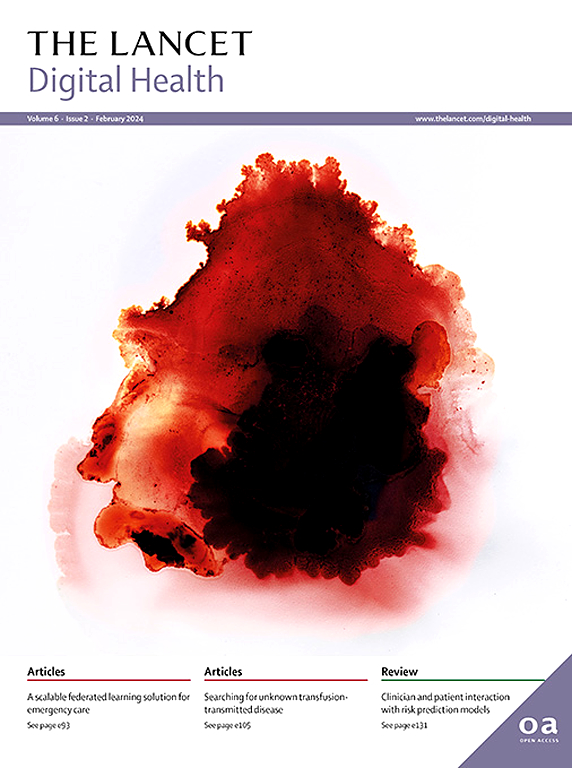Prevalence and demographics of 331 rare diseases and associated COVID-19-related mortality among 58 million individuals: a nationwide retrospective observational study
IF 23.8
1区 医学
Q1 MEDICAL INFORMATICS
引用次数: 0
Abstract
Background
The Global Burden of Disease Study has provided key evidence to inform clinicians, researchers, and policy makers across common diseases, but no similar effort with a single-study design exists for hundreds of rare diseases. Consequently, for many rare conditions there is little population-level evidence, including prevalence and clinical vulnerability, resulting in an absence of evidence-based care that was prominent during the COVID-19 pandemic. We aimed to inform rare disease care by providing key descriptors from national data and explore the impact of rare diseases during the COVID-19 pandemic.
Methods
In this nationwide retrospective observational cohort study, we used the electronic health records (EHRs) of more than 58 million people in England, linking nine National Health Service datasets spanning health-care settings for people who were alive on Jan 23, 2020. Starting with all rare diseases listed in Orphanet (an extensive online resource for rare diseases), we quality assured and filtered down to analyse 331 conditions mapped to ICD-10 or Systemized Nomenclature of Medicine–Clinical Terms that were clinically validated in our dataset. For all 331 rare diseases, we calculated population prevalences, analysed patients’ clinical and demographic details, and investigated mortality with SARS-CoV-2. We assessed COVID-19-related mortality by comparing cohorts of patients for each rare disease and rare disease category with controls matched for age group, sex, ethnicity, and vaccination status, at a ratio of two controls per individual with a rare disease.
Findings
Of 58 162 316 individuals, we identified 894 396 with at least one rare disease and assessed COVID-19-related mortality between Sept 1, 2020, and Nov 30, 2021. We calculated reproducible estimates, adjusted for age and sex, for all 331 rare diseases, including for 186 (56·2%) conditions without existing prevalence estimates in Orphanet. 49 rare diseases were significantly more frequent in female individuals than in male individuals, and 62 were significantly more frequent in male individuals than in female individuals; 47 were significantly more frequent in Asian or British Asian individuals than in White individuals; and 22 were significantly more frequent in Black or Black British individuals than in White individuals. 37 rare diseases were significantly more frequent in the White population compared with either the Black or Asian population. 7965 (0·9%) of 894 396 patients with a rare disease died from COVID-19, compared with 141 287 (0·2%) of 58 162 316 in the full study population. In fully vaccinated individuals, the risk of COVID-19-related mortality was significantly higher for eight rare diseases, with patients with bullous pemphigoid (hazard ratio 8·07, 95% CI 3·01–21·62) being at highest risk.
Interpretation
Our study highlights that national-scale EHRs provide a unique resource to estimate detailed prevalence, clinical, and demographic data for rare diseases. Using COVID-19-related mortality analysis, we showed the power of large-scale EHRs in providing insights to inform public health decision making for these often neglected patient populations.
Funding
British Heart Foundation Data Science Centre, led by Health Data Research UK.
5,800 万人中 331 种罕见病的患病率和人口统计学特征以及与 COVID-19 相关的死亡率:一项全国范围的回顾性观察研究。
背景:全球疾病负担研究为临床医生、研究人员和政策制定者提供了关于常见疾病的关键证据,但没有针对数百种罕见疾病的类似研究设计。因此,对于许多罕见疾病,几乎没有人口水平的证据,包括患病率和临床易感性,导致缺乏在COVID-19大流行期间突出的循证护理。我们的目标是通过提供来自国家数据的关键描述符,为罕见病护理提供信息,并探索COVID-19大流行期间罕见病的影响。方法:在这项全国性的回顾性观察性队列研究中,我们使用了英国超过5800万人的电子健康记录(EHRs),将9个国家卫生服务数据集连接起来,这些数据集涵盖了2020年1月23日活着的人的医疗保健设置。从孤儿院(一个广泛的罕见病在线资源)中列出的所有罕见病开始,我们保证质量并过滤下来分析331种疾病,这些疾病映射到ICD-10或医学-临床术语系统化命名法,这些疾病在我们的数据集中得到了临床验证。对于所有331种罕见疾病,我们计算了人群患病率,分析了患者的临床和人口统计学细节,并调查了SARS-CoV-2的死亡率。我们通过比较每种罕见疾病和罕见疾病类别的患者队列与与年龄、性别、种族和疫苗接种状况相匹配的对照组,以每名罕见疾病患者两名对照组的比例评估covid -19相关死亡率。研究结果:在58 162 316例个体中,我们确定了894 396例至少患有一种罕见疾病,并评估了2020年9月1日至2021年11月30日期间与covid -19相关的死亡率。我们计算了所有331种罕见病的可重复估计值,并对年龄和性别进行了调整,其中包括186种(56.2%)在Orphanet中没有现有患病率估计值的疾病。49种罕见病在女性个体中显著高于男性个体,62种罕见病在男性个体中显著高于女性个体;47在亚洲人或英国亚裔人中比在白人中更常见;22在英国黑人中比在白人中更常见。37种罕见疾病在白人人群中的发病率明显高于黑人或亚洲人。894 396例罕见病患者中有7965例(0.9%)死于COVID-19,而在整个研究人群中,58 162 316例中有141 287例(0.2%)死亡。在完全接种疫苗的人群中,8种罕见疾病与covid -19相关的死亡率风险显著升高,其中大疱性类天疱疮患者(风险比为8.07,95% CI为3.01 - 21.62)的风险最高。解释:我们的研究强调,国家规模的电子病历提供了一个独特的资源来估计罕见病的详细患病率、临床和人口统计数据。利用与covid -19相关的死亡率分析,我们展示了大规模电子病历在为这些经常被忽视的患者群体提供见解,为公共卫生决策提供信息方面的力量。资助:英国心脏基金会数据科学中心,由英国健康数据研究中心领导。
本文章由计算机程序翻译,如有差异,请以英文原文为准。
求助全文
约1分钟内获得全文
求助全文
来源期刊

Lancet Digital Health
Multiple-
CiteScore
41.20
自引率
1.60%
发文量
232
审稿时长
13 weeks
期刊介绍:
The Lancet Digital Health publishes important, innovative, and practice-changing research on any topic connected with digital technology in clinical medicine, public health, and global health.
The journal’s open access content crosses subject boundaries, building bridges between health professionals and researchers.By bringing together the most important advances in this multidisciplinary field,The Lancet Digital Health is the most prominent publishing venue in digital health.
We publish a range of content types including Articles,Review, Comment, and Correspondence, contributing to promoting digital technologies in health practice worldwide.
 求助内容:
求助内容: 应助结果提醒方式:
应助结果提醒方式:


